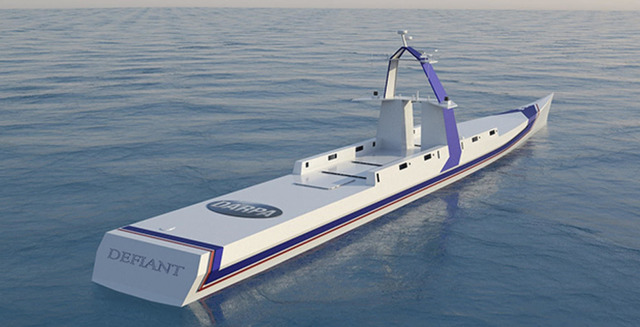According to relevant foreign publications, the Agency for Advanced Research Projects of the US Department of Defense (DARPA) in August 2022 announced plans to begin testing the first crewless ship (No Manning Required Ship, NOMARS) at the end of 2024.
The first product under the NOMARS program, Defiant, will be the first of its kind 210-ton medium Unmanned Surface Vehicle (MUSV). The purpose of its development is to maximize productivity, reliability and service efficiency while maintaining the ability to carry a significant payload at tactically useful ranges.
DARPA Program Manager Gregory Avicola, when asked about the timing of the creation of the head MUSV, replied that the agency would not specify the exact dates. However, he added that the expected tests of the vessel will begin at the end of 2024.
It should be noted that the US Navy Command considers large and medium-sized unmanned surface vessels (USVs) as an important part of the future uninhabited fleet, increasing the number of forces and suitable for joint operations with traditional large and small surface ships, destroyers and frigates. To this end, efforts are being made in the US naval sector to develop and test ever larger platforms.
The construction, testing and demonstration of the vessel under the NOMARS project constitute the second phase of the program, within which the results of the work of Serco (Australia) have already been selected. According to DARPA, during the first phase of NOMARS, Serco developed a set of design tools (Design Space Exploration, DSX) to evaluate the design of the ship for compliance with a "diverse" set of characteristics and objective limitations.
The company used DSX tools to create a collection of vessel designs with a displacement of 170 to 270 tons, which were then finalized in one iteration for preliminary consideration of the project. At the second stage, it is planned to finalize the design of the Defiant, build a vessel, and then conduct a series of tests on the eve of a three-month demonstration event at sea.

Serco used special tools to develop the final NOMARS conceptTo implement its developments, Serco cooperates with companies Beier Integrated Systems, Caterpillar, DRS Naval Power Systems, Ice Floe, Metron, Submergence Group and Thrustmaster from Texas.
According to G. Avicola: "The goal is to demonstrate the reliability and maintainability of NOMARS design principles at sea. We hope that these lessons will serve as a basis for future USV projects and how they can be used as fleet assets."
The NOMARS program adheres to a strict approach to ship design, one of the requirements of which is that a person should never get on board a ship while it is at sea. DARPA stated that the elimination of "all restrictions and requirements" associated with human operators allowed the creation of new configurations and capabilities of ships that were never considered for crewed platforms or optionally crewed.
This fundamental principle of NOMARS is aimed at pushing the boundaries of product reliability, since there is no one on board who could service it. As a result, new approaches to energy generation, movement, the composition of mechanisms and control schemes were required to ensure the continuous operation of the platform during navigation in various environmental and atmospheric conditions.
The NOMARS program adheres to a philosophy known as "gradual degradation", in which individual equipment is allowed to fail over time, having sufficient redundancy at the system level to still meet the requirements at speeds of at least 15 km/h after a year at sea. According to DARPA, the main components of the system of the chosen design are modular, which allows repairs to be carried out worldwide using equipment available at typical yacht shipyards.
According to the agency's representatives, this maintenance philosophy promotes rapid renewal and allows ships to spend most of their service life at sea, performing missions. Ultra-reliability is achieved through the integration of distributed hybrid power generation, removable propellers and high-capacity batteries.
According to the materials of the resource shephardmedia.com

